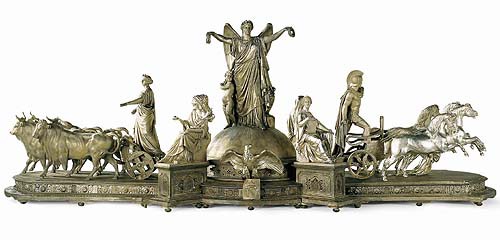This garniture for the hundred-piece table service, today exhibited at the Musée des Arts Décoratifs in the gallery dedicated to the Universal Exhibitions, is a fine example of the virtuosity of Second Empire industrial art. The Prince President Louis-Napoléon Bonaparte commissioned the garniture from the celebrated jewellers Christofle in 1852, and it was to be used for formal banquets at the Tuileries Palace. Charles Christofle (1805-1863) began working as a jeweller in 1830, and he was to become the world's largest jeweller as a result of the patents which he possessed for electrolytic gilding (both gold and silver) – indeed, he was to have a monopoly on the process until 1854. By combining expertise in the new technology with aggressive marketing policies, Christofle produced massive quantities of silverware at prices well below those of traditional jewellers, thus establishing a broad-based bourgeois clientele throughout the world.
This Napoleon III ‘surtout de table' garniture was produced for a thirty-metre table designed to accommodate one hundred diners, and it was presented at the Universal exhibition of 1855. The ‘surtout' comprised fifteen objects produced using the process called ‘Galvanoplastie', in other words, the plating of bronze with silver via electrolysis. The monumental tripartite centre piece of the garniture, ‘France distributing wreaths of glory', is veritable political manifesto. In the centre, France, personified by a winged victory holding two bay leaf/oak leaf wreaths, rears up against the celestial vault with sun rays (a reference to the Enlightenment) pouring from her. Before her is an imperial eagle atop a crowned capital N. She is flanked by the seated allegories of Justice, Concord, Force and Religion. To the right, stands the chariot of war, drawn by four charging stallions and driven by a Greek soldier in arms; to the left, is the chariot of pace drawn by four bulls and driven by an antique figure.
Though caught in the fire at the Tuileries Palace in 1871, the centre piece for the hundred-piece service survived and was pulled out of the still-smoking ruins by Henri Bouihlet, nephew of Christofle and vice-president of the manufactory. It was deliberately left in its final state and still bears the stigmata, including dents and rough edges. It was given by Bouihlet to the Musée des Arts décoratifs. As for the other pieces in the garniture – the major towns in France and allegories of Commerce and Agriculture, the Sciences and the Arts… – all that remains is their bases.
Karine Huguenaud (tr. P.H.)
April 2008
The ‘surtout de table’ garniture for the hundred-piece table service: "France distributing wreaths of glory"
Artist(s) : CHRISTOFLE (Manufacture)

- Date :
- 1852-1858
- Technique :
- ‘galvanic' bronze and gilt bronze
- Dimensions :
- H = 1 m, L = 2.92 m, P = 1.05 m
- Place held :
- Paris, Musée des Arts décoratifs
- Photo credit :
- © Les Arts Décoratifs

